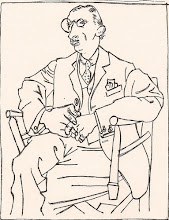


In the past few weeks, I have spent many nights viewing some of Italian auteur Federico Fellini's masterpieces: La Strada, La Dolce Vita, and 8 1/2. These films represent the best of Fellini's works and show his passage from neo-realism to autobiographical surrealism. La Dolce Vita is considered by many to be the breaking point from neo-realism into a more surrealist realm that is hugely present in 8 1/2. When watching these three films, one can truly see the transformation of an artisit and his work, much like the painting periods of Picasso. Although all three of these films are very different, they have a magical quality that ties all of Fellini's work. It is a deep understanding of human nature and his quest for truth through his art.
In 1954, Fellini made the beautiful and heartbreaking film La Strada, which in English means "The Road". It is the story of a childlike woman Gelsomina who is sold by her mother for ten thousand lire to the harsh traveling performer Zampano to support Gelsomina's younger sisters. Zampano trains Gelsomina to be his assistant by beating her until she gets it right. The rest of the fable chronicles Gelsomina's and Zampano's life on la strada performing on street corners and in circuses. On their travels, Gelsomina meets Il Matto, or the Fool. Il Matto taunts Zampano relentlessly, and Zampano threatens him with death. Although this character has a tragic flaw, he tells Gelsomina that it is her purpose in life to accompany Zampano, so she continues to follow him. On the Criterion Collection DVD of La Strada, Martin Scorsese gives a wonderful introduction to film. Scorsese considers La Strada his favorite of Fellini's films, and it is easy to see how Fellini's neorealism influenced many of Scorsese's films about life in New York City and the challenges the people of the city faced. Scorsese also comments about the influence of Zampano on many of his film characters, like Jake LaMotta in Raging Bull. But aside from the influence Fellini had on him, Scorsese gives a wonderful insight into the heart of the film and of Italian neorealism in general. He mentions how the neorealists used the teachings of St. Francis of Assisi as major themes in their films. After researching the Franciscan teachings, the influence of them is clearly evident in La Strada. Though Gelsomina is very childlike, she has a saintly demeanor that perfectly paralells the life of St. Francis. She loves everything unconditionally and has a passion for all of God's creation, which is how St. Francis lived his life. In the widely known Prayer of St. Francis it says "Where there is hatred, let me bring love; where there is sadness, let me bring joy...it is in pardoning that we are pardoned." Gelsomina lives by this law in her life and in loving Zampano, forgives him for her suffering. But when Zampano kills Il Matto, her spark of life is exinguished and she is consumed with Il Matto's death, saying continually "The Fool is hurt". Eventually, Zampano leaves her and goes on, but in a redeeming act of kindness leaves with her the trumpet she loved to play. Years later Zampano hears the haunting tune Gelsomina played on the trumpet and learns of her death. After this he falls into a drunken depression and in the final frame is seen crying desperately for his lost redeemer. With La Strada, Fellini creates a perfect film that exemplifies the trademarks of Italian neorealism by showing an impoverished Italy jaded by the horrors of WWII. Redemption through a childlike saint is offered to a broken and battered man who has forgotten how to love, but in a cruel world of war and poverty, the hope of redemption seems lost. War has destroyed the Franciscan virtues of love and redemption.
The next movement in Fellini's art comes in La Dolce Vita, an expose on the Italian culture that arose out of the despair after WWII. Fellini explores the meaning of life and the search for love by exposing "the sweet life". The grand opening shot shows a giant statue of Jesus being taken to the Vatican on a helicopter. The main character Marcello, an exploitative journalist, is following the statue on a helicopter behind the other. As Marcello follows stories about the rich and famous, he searches for meaning in his life. A beautiful young actress arrives in Rome and he is infatuated with her, and eventually takes her to the Trevi Fountain in one of the film's most famous scences. Marcello discovers he doesn't want that celebrity life, so he follows the lead of a story about a miracle of two children who claim to see the Madonna. It is obviously a fake and is exploited grandly by the paparazzi, a term coined from this film. After his experience with the miracle he goes to friend's home who seems to have the perfect life: two children, a wife, a large home; yet something troubles his friend Steiner. He fears peace because he suspects behind it lies the greatest evil. Marcello continues his search with parties, women, and journalism, and then learns of the double homicide and suicide commited by Steiner. When this happens he gives up his search and leads a meaningless life of decadence. In the final sequence Marcello is on a beach and sees a young girl he met at a cafe. He is separted from her by a channel of water, symbolizing his separation from the girl's innocence and a life with meaning. In this epic film, Fellini shows how meaningless things like religion have become, and how other truly meaningless things like celebrity, money, and "the sweet life", have created a decadent culture. The once meaningful principles of people like St. Francis of Assisi have been battered and beaten until they are no more meaningful than a Hollywood harlot. The transformation from La Strada to La Dolce Vita is evident in the slightly surreal elements of the film, beginning with the statue of Jesus, the party at the castle near the film's climax, and the beach scene at the end. It is a small preview of the totally dreamlike 8 1/2 that follows.
8 1/2 is Fellini's first venture into the world of surrealism and the precursor to his later, very autobiographical films. Fellini started making this film without really knowing where it was headed, much like the main character Guido's dilemma in the film. The film opens with Guido stuck in traffic in his car where he becomes extremely claustrophobic. People look on with ominous still glares and eventually he escapes and floats above the traffic and above the ocean. But he is attached to the ground by a rope an is pulled back down into reality. This sequence sets up the theme for the film of a man wanting to escape the madness and pressures of the world and forget his past. Guido is a womanizer, but is married to a wife who is growing more cynical by the day. He is working on a new project, but doesn't know what it's about. While he is negotiating the workings of the film at a spa, he has visions of his mother and father; his childhood in school; summoning Saraghina to do the rumba. The most lavish and poignant of all the dream sequences is when he dreams of having a harem filled with the women in his life competing for his attention and catering to his every need. He sends the ones who become too old upstairs to live, and when this happens he is faced with the reality of how badly he treats women. But the best of these sequences is the final one at the spaceship launch tower, a prop that was built and had no use, where everyone from his past and present joins in a circus of music and dancing around a ring. Through this surreal masterpiece, Fellini offers a more lighthearted message than his other, more serious films. He states through all the madness that if we live our lives with regret and in the chaos we create for ourselves, we will never live freely and have meaning in our lives.
These three mesmerizing and amazing films chronicle the journey of a great artist through three unique phases of neorealim, post-neorealsim, and finally surrealism. Although Fellini is a master of his craft and one of the greatest directors who ever lived, he is never pretentious in his work. He retains a graceful, human quality in all of his films that has become widely known as "Felliniesque". His films are carefully choreographed films and play like the most fantastic ballet where every step is perfect and at the end, you know you have witnessed something beautiful and extraordinary.












